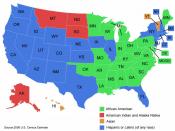Bilingual Education Helps Minority Children Bilingual education programs help children from other cultures learn a common language. At the same time however, bilingual education helps minority groups remember their heritage and appreciate their culture. In America there are over 150 different languages that are spoken by some two million children in American schools that have a different home language other than English. Children of minority groups speak Spanish, Italian, Arapaho, Cherokee, Polish, and Zuni, as well as many others. A new language gives a child the power to enter a new world.
Each new language that a person knows gives them more knowledge. Each language that we know gives us a chance to access a new worldview, a new way of thinking, new feelings, and new interpretations of reality that are unique to that language. We are all born into a certain language, and that is the language that we are use to communicating with others.
This language that we are born into determines what we will notice and know, and holds us from acknowledging and knowing others.
Bilingual education helps children a lot. It is a program where language meets language, culture meets culture, and values meet values. In America, bilingual education introduces children to a new common language, English. There are sharp differences in cultural values, but learning a new language helps children interact with children from a different culture. Bilingual education expands the world for children.


